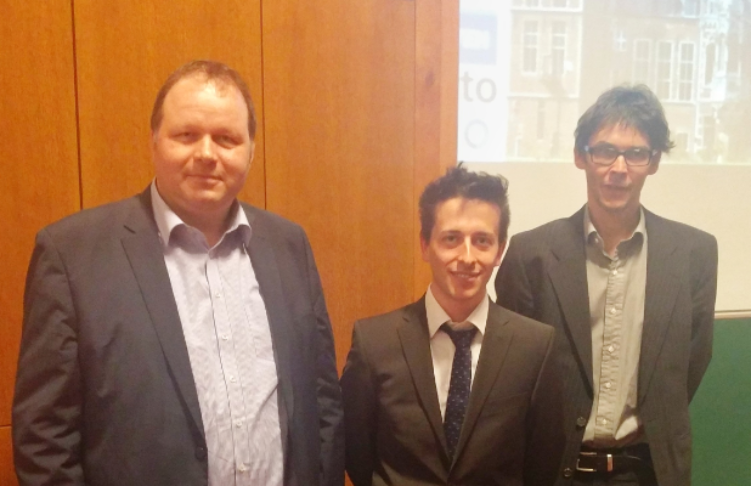 On May 8, 2017, Joris Roosen (SIM² KU Leuven & LIC) successfully defended and obtained his PhD degree at KU Leuven. The topic of Roosen’s PhD dissertation is “RECOVERY OF CRITICAL METALS FROM DILUTE AQUEOUS WASTE STREAMS BY ADSORPTION ON FUNCTIONALIZED BIOPOLYMERS”. This work was funded by VITO, the Research Foundation Flanders (FWO, PhD fellowship) and KU Leuven. The full text will become available once all research results have been officially published in the peer-reviewed literature. The already published papers can be found below. Supervisors for Dr. Roosen were Prof. Koen Binnemans (KU Leuven) and Dr. Steven Mullens (VITO). Dr. Roosen will now continue his research career as a postdoc in the Group of Prof. Koen Binnemans (KU Leuven) where he will work on the SIM Get-A-Met project.
On May 8, 2017, Joris Roosen (SIM² KU Leuven & LIC) successfully defended and obtained his PhD degree at KU Leuven. The topic of Roosen’s PhD dissertation is “RECOVERY OF CRITICAL METALS FROM DILUTE AQUEOUS WASTE STREAMS BY ADSORPTION ON FUNCTIONALIZED BIOPOLYMERS”. This work was funded by VITO, the Research Foundation Flanders (FWO, PhD fellowship) and KU Leuven. The full text will become available once all research results have been officially published in the peer-reviewed literature. The already published papers can be found below. Supervisors for Dr. Roosen were Prof. Koen Binnemans (KU Leuven) and Dr. Steven Mullens (VITO). Dr. Roosen will now continue his research career as a postdoc in the Group of Prof. Koen Binnemans (KU Leuven) where he will work on the SIM Get-A-Met project.
Publications by Joris Roosen in the framework of this PhD
- J. Roosen, S. Mullens, K. Binnemans, “Multifunctional alginate-sulfonate silica sphere-shaped adsorbent particles for the recovery of indium(III) from secondary resources”, manuscript submitted and under review.
- J. Roosen, S. Mullens, K. Binnemans, “Chemical immobilization of 8-hydroxyquinoline and 8-hydroxyquinaldine on chitosan-silica adsorbent materials for the selective recovery of gallium from Bayer liquor”, manuscript under revision.
- E. Kim, J. Roosen, L. Horckmans, J. Spooren, K. Broos, K. Binnemans, K.C. Vrancken, M. Quaghebeur, “Process development for hydrometallurgical recovery of valuable metals from sulfide-rich residue generated in a secondary lead smelter”, Hydrometallurgy, 169, 2017, 589-598. Download here
- J. Roosen, S. Van Roosendael, C. R. Borra, T. Van Gerven, S. Mullens, K. Binnemans, “Recovery of scandium from leachates of Greek bauxite residue by adsorption on functionalized chitosan–silica hybrid materials”, Green Chemistry, 18, 2016, 2005-2013. Download here.
- J. Roosen, J. Pype, K. Binnemans, S. Mullens, “Shaping of Alginate–Silica Hybrid Materials into Microspheres through Vibrating-Nozzle Technology and Their Use for the Recovery of Neodymium from Aqueous Solutions”, Industrial & Engineering Chemistry Research, 2015, 54, 12836-12846. Download here.
- J. Roosen, J. Spooren, K. Binnemans, “Adsorption performance of functionalized chitosan-silica hybrid materials toward rare earths”, Journal of Materials Chemistry A, 2014, 2, 19415-19426. Download here
- J. Roosen, K. Binnemans, “Adsorption and chromatographic separation of rare earths with EDTA- and DTPA-functionalized chitosan biopolymers”, Journal of Materials Chemistry A, 2014, 2, 1530-1540. Download here
Public abstract PhD Joris Roosen
A circular economy aims at a more efficient use of resources by closing the materials loop and reusing “waste” as a secondary raw materials source. This can be challenging and demands for new methods to be explored. For instance, in the case of dilute waste streams from industrial processes, the challenge is to efficiently recover very low concentrations of valuable metals from huge volumes of waste water. Adsorption is considered to be the key technology to do so. During this PhD, the biopolymers chitosan and alginate were examined for the adsorption of critical metals from dilute aqueous solutions. Biopolymers are biologically renewable, which makes them easily available, in any quantity and at low cost. They have interesting physicochemical characteristics and are characterized by an abundant availability of functional groups. These provide biopolymers with a high adsorption capacity and can be used as well to immobilize chelating agents on the adsorbent matrix, thus increasing the selectivity for specifically targeted metal ions. Chitosan-silica hybrid materials were functionalized with the organic ligands EDTA and DTPA for the adsorption of lanthanides, EGTA for the selective recovery of scandium from leachates of Greek bauxite residue and 8-hydroxyquinaldine for the separation of gallium from aluminium out of spent Bayer liquor. In addition to chemical modifications, the adsorption performance was further improved through the morphology of the adsorbent materials. With the aim to develop materials that are industrially applicable for a broad range of process configurations, porous microspheres were created from alginate by the vibrating-nozzle technology and the incorporation of a stable silica matrix was investigated. Multifunctional alginate-sulfonate-silica spheres were created and studied for the selective recovery of indium from a simulated leachate of a zinc refinery residue. The functionalized biopolymer materials synthesized during this PhD have proven to be particularly suitable for the selective recovery and separation of critical metals from dilute aqueous waste streams. In time, this knowledge should allow a more efficient use of our resources in the transition towards a more sustainable future.





